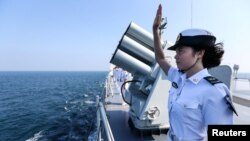A Chinese state institution warned this week that Beijing is ready to set up an air defense identification zone (ADIZ) over the contested South China Sea, giving it the authority to screen foreign aircraft. But analysts say any enforcement would anger other countries without deterring traffic.
That measure would follow a series of steps to control the movement of foreign ships in the same sea, underlining China's intent to hold its vast maritime claims after a world court tribunal ruled in July that it lacked a legal argument.
China calls 95 percent of the sea its own and its militarization of tiny islets since 2010 has angered officials from Jakarta to Washington. Beijing reportedly toyed with the idea of an ADIZ in July after the court verdict.
“More likely if they do decide to progress toward this, it would be kind of a patchwork approach in which military exercises have closure areas, and that would be the sort of trial point to extend the geographic scope of those or the duration of those from there rather than go for an all-out ADIZ,” said Euan Graham, international security director for the Lowy Institute for International Policy in Sydney.
The government-run Chinese think tank, the National Institute of South China Sea Studies, said that because of an estimated 700 U.S. surveillance patrols in the sea last year, Beijing was ready to set up the air zone unless Washington stopped the activity.
The U.S. government counts a lot of China’s neighbors as allies and calls most of the sea international waters. China says the rival superpower is trying to contain its expansion.
Brunei, Malaysia, Taiwan Vietnam and the Philippines also claim all or parts of a sea that’s rich in fisheries and may hold valuable undersea fossil fuel reserves. The South China sea covers 3.5 million square km (1.4 million square miles) from Taiwan to Singapore.
China could feasibly set up an air zone, called an ADIZ for short, using radars if it built up Scarborough Shoal west of the Philippines, said Carl Thayer, emeritus professor of politics at The University of New South Wales in Australia. That installation would give it the third corner of a triangle connecting the Paracel and Spratly island chains.
But since the arbitration ruling in July, other claimants have eagerly talked to China rather than testing the anti-Beijing verdict. Southeast Asian countries that compete with China for maritime control also look to it for trade and investment.
“I just don’t think the Chinese are in a capability position to (enforce and ADIZ),” Graham said. “I think the politics of the South China Sea at the moment are rolling their way and I think that would suggest a more cautious approach.”
Military aircraft from Japan, which has an East China Sea zone overlapping China’s, and the United States are flying through the ADIZ as usual. China has turned back only one aircraft, a commercial plane from Laos, citing an incomplete flight plan.
China has also established rules and assigned vessels to check foreign ships, with a fresh order in July this year. Those measures are also expected to have little impact on actual traffic.
Ships and boats must get approval from regional Chinese authorities before any fishing or surveying, state media said in December 2014. The order by Hainan province in southern China took effect in January 2015 and was set to cover two-thirds of the sea.
Vessels from Vietnam and the Philippines continue to use that tract of water as before. About half the world's marine shipping traffic also uses the South China Sea, and Beijing's orders have not disrupted it.
But this year the Chinese Maritime Safety Administration gave an order barring foreign vessels from a 63,000 square kilometer tract near Vietnam and the Paracels for a six-day naval exercise. U.S. ships said they would not honor the block, according to a U.S. Naval Institute report.
In one of its closest calls, China sent warships to trail the U.S. Navy’s USS Lassen destroyer as it passed within 12 nautical miles of an artificial island in the Spratly chain. The U.S. ship went to show the waters were free for international use.
But Thayer said to avoid a backlash from around the region, China will not stop marine shipping crucial to the economies of East Asia.
“I don’t think anybody in Southeast Asia believes China is going to interfere with commercial navigation,” Thayer said. “China, Japan, South Korea, Taiwan are just too dependent,” he said. “(If) China did something like that, it would affect the global economy. It would cause massive push back. China is really upset about military aircraft, ships, because it just claims stuff.”
This year China also built a second 10,000-ton coast guard cutter for “protecting China’s maritime rights,” the pro-Communist Party Global Times in Beijing said. The first ship began patrolling the East China Sea last year. Chinese coast guard vessels periodically travel with fishing boats for protection in the South China Sea.
China may want its rules, ships and infrastructure in place for selective, long-term use rather than to turn away every boat, said Andrew Yang, secretary general with the Chinese Council of Advanced Policy Studies think tank in Taiwan.
“I don’t think they’re going to do that aggressively,” Yang said. “Their infrastructure construction surrounding the Paracels and other South China Sea islands are already in place. So they just wait and see and just continue to do so.”













